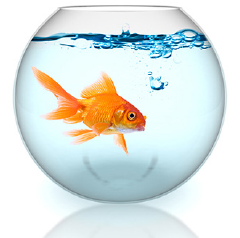This problem solving activity has a number (addition and subtraction) focus.
Millie needs to put her new fish into exactly one litre of water but she has just two measuring containers.
One holds seven litres and the other holds four litres.
How can she use these two containers to put exactly one litre of water into the fish tank?
- Manipulate numbers (using the number operations) to obtain a given number.
- Change a word problem into an arithmetic problem.
- Devise and use problem solving strategies to explore situations mathematically (guess and check, be systematic).
- Report the results of mathematical explorations concisely and coherently.
The problem involves finding a solution to a practical problem using a mathematical process. The students have to first make the observation that the amount of water in one container cannot be transferred into the other evenly. The students also need to understand that these containers can be used together as opposed to just being separate entities. When they start solving this problem they will probably use a guess and check method directly related to the physical problem. They can then be encouraged to identify the mathematics that is behind what they have done.
The key to the solution actually involves finding the difference between the amounts in the containers. As the number one is the focus point, the students must devise a solution that has one as the difference. This can be achieved by the following formula: (2 x 4) – 7 = 1.
This problem should help students to become more flexible with number and be open to new ways to look at apparently old situations.
- Copymaster of the problem (Māori)
- Containers to introduce the problem
- Copymaster of the problem (English)
The Problem
Millie needs to put her new fish into exactly one litre of water but she has just two measuring containers. One holds seven litres and the other holds four litres. How can she use these two containers to put exactly one litre of water into the fish tank?
Teaching Sequence
- Pose the problem to the class. First ask them what amounts of water they could make easily. Expect such answers as 4 litre, 7 litres, 8 litres, 11 litres and so on. Make a list.
- It may be useful at this stage to simplify the wording of the problem to:
How can you put 1L of water into the fish bowl using a 7 litre container and a 4 litre container? - As a class, brainstorm ideas of how to solve the problem. Record these as a reference for the students to view as they proceed through the problem.
- Pose these questions as the students then work on the problem in pairs:
What kind of approach have you taken? Why?
Can the problem be solved by more than one method?
How could you check to see if your answer was correct?
Will you use every drop of water or will you have to throw some away?
What other amounts can you make? - Encourage the students to record their working in a way that shows how they have reached their conclusion.
- As a class, display the students’ working and discuss the different solutions. A group could demonstrate the method using water and containers.
Extension
Using the same scenario as above, can you put exactly four litres of water into the fish tank using a five litre and a three litre container?
Solution
As we said above, students will probably come to this by guess and check. The most direct answer to the problem is based upon the expression 2 x 4 – 7 = 1. However, it can be solved using the more complicated expression 3 x 7 – 5 x 4 = 1.
- Fill the 4 litre container to the top.
- Pour this water into the 7 litre container. This leaves 3 litre empty.
- Fill the 4 litre container again.
- Pour this amount into the 7 litre container until it is filled to the top.
- As the 7 litre container could only hold another 3 litres, there should be 1 litre left over in the 4 litre container.
- Pour this litre of water into the fish bowl.
It may be worth noting that once you can get 1 litre you can get any amount simply by adding together enough ones. But there is often a more efficient way of doing things. For instance, 2 x 7 – 3 x 4 = 2, will provide the basis for getting two litres measured exactly.
Solution to the Extension
- Fill the 5 litre container to the top.
- Pour this amount into the 3 litre container. This leaves 2 litre in the 5 litre container.
- Tip out the water in the 3 litre container and replace it with the left over 2 litres.
- Fill the 5 litre container again.
- Pour this amount into the 3 litre container until it is filled.
- As the 3 litre container only needed 1 litre to be filled, there should be 4 litres left over in the 5 litre container.
- Pour the 4 litres of water into the fish bowl.
